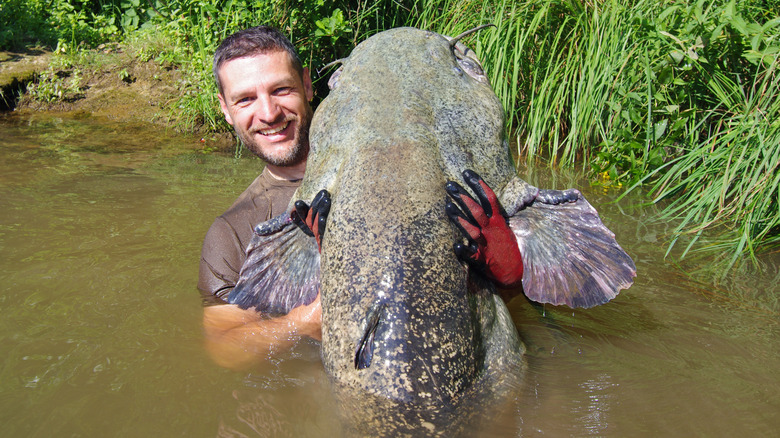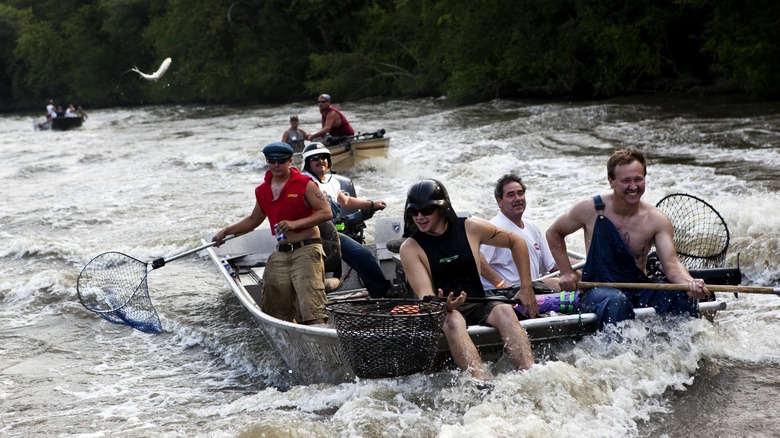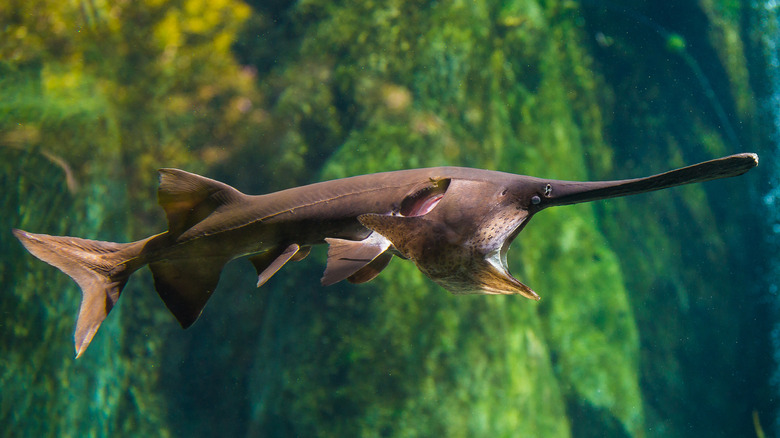The Strangest Fishing Methods You Didn't Even Know Existed
We may receive a commission on purchases made from links.
Fishing is one of the most popular outdoor recreational activities in the United States. For most Americans, whether they are an angler or not, recreational fishing means utilizing a rod and reel along with lures or bait to catch various gamefish. While there are some differences between fly fishing and conventional tackle angling or saltwater and freshwater fishing, by and large, most recreational fishing techniques at least have some common elements. However, there are a number of methods that barely resemble what is commonly thought of as fishing. These include some of the strangest fishing methods you didn't even know existed.
Some odd fishing methods, such as the Belgian tradition of horse trawling — using horses to pull seine nets through shallow water — evolved as a means of commercial fishing. However, the methods described below are all methods employed by recreational anglers. They involve utilizing a variety of objects, including buckets, nets, and bottles, as well as bare hands. One even uses a rod and reel, albeit in a much different way than the traditional method.
These methods have persisted because they work. However, before rushing out to try them for yourself, be advised there is some risk involved in a few of them. Additionally, some of these methods may not be legal in your area, as fish and game regulations vary from state to state. So, be sure and check the regulations for the area you intend to fish before employing these or any other angling techniques.
Noodling for catfish
Catfish noodling is about as base as it gets when it comes to recreational fishing. In simple terms, this method involves grabbing catfish with your hands and pulling them out of the water. Although all of the most common species of catfish — channel, blue, and flathead — are potential targets for noodlers, flatheads are the most common species sought by hand fishermen.
Noodling, however, isn't as easy as just sticking your hands in the water and grabbing fish. The best time for noodlers to target catfish is when they are spawning. During the spawn, female catfish will nest in cavities, holes, or depressions in relatively shallow water. So, they will likely be found in hollow trees, culverts, brush piles, or wash outs under banks. The idea is to slowly reach a hand into such an area and entice the catfish to grab and bite your hand. At this point, it's a matter of grabbing onto the catfish and wrestling it to the surface.
While catfish do not have teeth capable of puncturing skin, they do have raspy rows of teeth that will certainly scrape and tear at skin. For this reason, most noodlers wear cut resistant gloves to protect their hands. There are other tools and equipment that can be used in some of the 16 states in which noodling is currently legal. However, it is critical to carefully check regulations on what items may or may not be used to assist while noodling.
Skarping
Skarping is a response to the overwhelming spread of an invasive species in the Great Lakes region. The Asian carp were introduced to sewer treatment plants in the U.S. in the 1960s in order to help control aquatic growth. However, they not only escaped into natural waterways, but began to overpopulate to the point they have severely damaged and, in some cases, even destroyed some native species. The Illinois River, in particular, is home to an inordinate number of these fish.
Fishery managers in affected states have tried a variety of methods to control the population and spread of these invasive fish. Large scale netting operations, along with encouraging recreational anglers to remove as many fish as possible are among the more common measures. It is worth noting, these huge hauls of carp are put to good use — most being utilized to help supply various outreach programs providing food to the needy. However, these efforts barely put a dent in the population.
Because Asian carp tend to go airborne when startled by boat engines or other loud noises, they also quickly became a threat to boaters, water skiers, and fishermen. However, intrepid fishermen began using this behavior as a creative way to capture the carp. Arming themselves with large landing nets and helmets, fishermen cruise on boats, jet skis, and water skis and scoop the fish in mid-air as they jump. A number of tournaments, derbies, and contests, such as the Redneck Fishing Tournament, have been created around this type of fishing, which has become known as skarping.
Snagging paddlefish
Paddlefish are odd looking fish. So, perhaps it is only fitting that an odd method is used to catch them. Unlike other techniques on this list, this method actually uses rod and reel. Despite their looks, paddlefish are actually highly sought-after for both their fillets and roe, which is renowned as caviar. The problem facing fishermen hoping to catch paddlefish is that these prehistoric-looking fish only eat plankton. Since these fish won't eat lures and baits typically used by anglers, fishermen came up with a new solution — snagging.
Snagging is pretty much what the name suggests. Fishermen cast a large hook and heavy weight, then use a sweeping motion of the rod to try to embed the hook into the fish. Typically, a heavy rod and line are necessary to handle both the heavy weight and the paddlefish, which can grow to nearly 200 pounds. While snagging is most often associated with paddlefish, in some areas it is also used for species such as salmon.
Like other fishing methods, snagging is not legal in every state. Additionally, in states where it is legal, it isn't allowed for all species or every water body and strict limits are in place. Be sure to check the regulations for the state, as well as the body of water you are planning to fish before engaging in snagging as a fishing method.
Bucket fishing
Bucket fishing does not refer to sitting on a bucket while fishing, although that is quite common in some regions. Rather, this technique involves using a bucket to catch fish. Primarily used to catch catfish, bucket fishing essentially involves creating a fish trap from a bucket, can, or other container. There are a variety of ways to accomplish this, but the premise in each is the same–– the catfish takes up residence in the bucket and then is captured by the fisherman.
Creating a fish trap from a bucket, can or barrel can be done in several ways. If the bucket has a lid, cut an opening in the lid that will allow the fish to swim in. If there is no lid, bend the opening of the can or barrel to where all but a small portion of the opening is closed off. If the bucket is rubber or plastic, rope can be used to lace the sides of the bucket closed. Regardless of the method used to restrict the opening, it is helpful to drill holes in the sides and bottom of the bucket to release water as it is lifted.
To set the trap, tie a rope to the bucket and lower it into the water. One or more buckets can be set out at a time. Depending on the depth of water, a rock or other object can be placed in the bucket to help keep it on the bottom. Tie the rope to a limb or pole and allow the bucket to remain on the bottom for a day or so. To check for fish, you can either enter the water and cover the hole before lifting the bucket in order to trap fish inside or lift the bucket up into a boat, pulling the line in quickly so the fish don't escape.
Hand lining
Hand line fishing, also known as handlining, is a very basic form of fishing with a bait or lure. It is essentially the same as conventional tackle fishing, just minus the rod and reel. It involves using a length of line along with a baited hook or lure. It is cast by hand, rather than with a rod. It is also retrieved by pulling the line in by hand. Often, the line is wrapped on a plastic handline spool, known as a hand reel, a stick or wooden dowel, or even a plastic bottle to keep it from tangling during the retrieve or while fighting a fish.
Given that hand line fishing is still an attempt to get fish to bite, it is equally important for handliners to choose the best lures and baits and pick the best times of day to fish in order to be successful. It is also important to note that fishing line is quite capable of cutting into fingers and hands when under tension. So, it is advisable to wear gloves when hand line fishing for larger fish species.
This basic form of fishing has been around since man first fashioned line and hooks. Today it is most popular among minimalists looking for a different experience. It is also a popular form of fishing for travelers, as it is easy to pack a handline rig and a small selection of tackle. It is also a good idea for any outdoor adventurer to keep a hand line fishing setup in their emergency survival gear bag.





